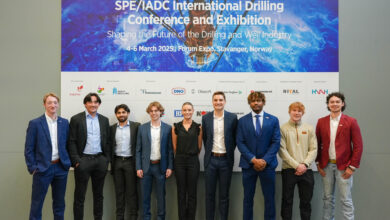Technical Session 13 – Management & HSE
Editor’s note: These abstracts have been edited for space and clarity. This program is current as of 15 January 2013. Additions, withdrawals and other changes to the conference program after this date may not be reflected. Click here for the most updated program.
TECHNICAL SESSION 13: MANAGEMENT AND HSE
SPE/IADC 163422
Drilling Systems Automation – Preparing for the Big Jump Forward, J.P. de Wardt, de Wardt and Co; M. Behounek, Apache Corp; C.D. Chapman, Schlumberger; D. Putra, Schlumberger Cambridge Research
Results and knowledge shared from the SPE Workshop held in Vail, Colo., in July 2012 (Well Construction Automation – Preparing for the Big Jump Forward) will be presented.
SPE/IADC 163483
Macondo Litigation and its Impact on the Offshore Industry – What Every Operator, Driller, Service and Supply Company Needs to Know!, C. Moomjian Jr, CAM OilServ Advisors
Macondo is a “game changer” that will substantially impact the industry from an operational, contractual and risk management perspective.
Decisions in the Macondo litigation that are pending in a US District Court in New Orleans will impact operators, drillers, service and supply companies in respect of pollution liability in general and contractual indemnity/release provisions in particular.
This paper reviews and analyzes landmark court decisions on summary judgment motions regarding interpretation, applicability and enforceability of the indemnification provisions and releases in the drilling and cementing contracts that were applicable to the Macondo well.
SPE/IADC 163489
Operational Control and Managing Change: the Integration of Non-Technical Skills with Workplace Procedures, J.L. Thorogood, Drilling Global Consultant LLP; M.T. Crichton, People Factor Consultants
The paper will outline common pitfalls and problems associated with managing operations. It will draw on existing operational decision-making literature and the authors’ experience researching these problems and working with operations teams. It will discuss the non-technical skills required to manage operations effectively, the organizational structures that are most operationally effective and describe techniques for training teams and helping to develop the competencies to manage operations safely and deal effectively with uncertainty.
SPE/IADC 163402
Delivering Consistent Top-Quartile Drilling Performance without Compromise, M. Cockram, F. Stewart, A. Ritchie, BG Norge; F. Hevrøy, S. Bjarne Barke, Seadrill
BG Norge embarked on a five-well exploration, appraisal and development campaign with the West Alpha between 2009 and 2011. The rig was part of a three year, 17-well rig sharing consortium that involved four other operators. Following and expanding upon the management approach outlined in IADC/SPE 87118, BG Group developed a strong relationship with the rig contractor, Seadrill, and delivered exceptional results.
This paper will outline the management process taken by BG Group and Seadrill that enabled improved performance.
SPE/IADC 163510
Advanced Dynamic Training Simulator For Drilling as Well as Related Experience from Training of Drilling Teams with Focus on Realistic Downhole Feedback, S. Ødegård, Ø. Mehus, Oiltec Solutions; R. Rommetveit, eDrilling Solutions; B.T. Risvik, Statoil ASA; K. Bjorkevoll, SINTEF Petroleum Research
The paper presents a highly advanced training simulator that combines an advanced topside simulator with a dynamic downhole simulator with an advanced transient integrated hydraulics and thermal wellbore model and a dynamic torque and drag model. The simulator is aimed at drilling and well operations, and is able to handle all normal operations, including high-pressure, high-temperature wells, through-tubing rotary drilling, extended reach drilling and managed pressure drilling.
SPE/IADC 163528
Dust Collection System for Personnel Health During Fracturing Operations, M.L. Boucher, T. Anderson, C. Hooker, A. Uttecht, National Oilwell Varco
The rapid expansion of the hydraulic fracturing industry has in some places outpaced necessary regulations and equipment for worker safety, especially dust control. A dust collection system has been developed to target specific points, including the hopper and blender where sand particles are likely to be released into the air.
With a system in place that meets OSHA standards, the threat of silicosis is eliminated from the hydraulic fracture process and unconventional development is made safer for everyone involved. This paper will discuss the dust collection equipment, its deployment and integration with existing equipment, and field results.
E-POSTERS:
SPE/IADC 163552
From Research to Practice: A Story of an Actionable Safety Leading Indicator Index, J. Stough, IHS
For the past several years, a group of global energy companies, including nearly all of the super majors, has been working on a research initiative with a common mission to find an actionable leading indicator index to drive safety and eventually overall sustainability performance.
This paper will review the leading indicator research findings drawn from analyzing a large energy industry data set.
SPE/IADC 163816
Evolution of Drilling and Completions in the Slave Point to Optimize Economics, J. Hollan, Packers Plus Energy Services; B. Schaab, N.B. Lerner, Penn West Exploration
This paper will detail the evolution of drilling and completion practices and technologies utilized to optimize economic development of the Slave Point carbonate formation in northern Alberta. The Slave Point was originally developed in the 1960s with vertical wells, but success depended on localized reservoir quality. Horizontal drilling and multistage fracturing completions have opened up lower-porosity regions enhancing recoveries from zones that were once deemed uneconomic.
SPE/IADC 163559
Investing in Greener Growth: Making the Business Case for Environmental Solutions, L. Brantley, J. Kent, L. Sallee, National Oilwell Varco
This paper will analyze the business case for environmental solutions from the perspective of an equipment manufacturer and technology and services provider.
SPE/IADC 163431
Remote Operations Center – An Efficient and Highly Competent Environment to Optimize Operational Performance and Reduce Risk, A.K. Thorsen, E. Saeverhagen, N. Spanovic, J. Dagestad, J. Fraser, Baker Hughes
To illustrate the data gathering and risk mitigation aspect of a remote operational center, the BEACON center concept is used to display the workflows, data analysis and feedback to the rigsite for maximum progress and minimum risk. Areas from subsurface understanding through drilling optimization and BHA reliability will be covered.
SPE/IADC 163451
A Collaborative Approach for Planning a Drilling with Liner Operation, S.M. Rosenberg, T. Cummins, T. Dunn, M.Z. Tan, Weatherford International
This paper will illustrate the collaborative approach an international oilfield services company used for planning a drilling with liner (DwL) operation to isolate a 6.5 ppg depleted sand interval in a deepwater block of Mississippi Canyon. Early collaboration between the service company and operator identified DwL technology as the core technology to meet the operator’s well objectives.




